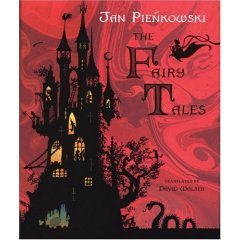
Forgotten Bookshelf: The Fairy Tales
illustrated by Jan Pieńkowski
translated from Grimm and Perrault by David Walser
William Heinemann Ltd. and Gallery Five Ltd., 1977
Reissued in the U.S. 2006 by Viking
Here are my requirements for a good anthology of traditional folklore: the translations have got to be good, but most importantly, the illustrations have to be GORGEOUS. And there must be lots of them. On every page. In all of these aspects, Pieńkowski's treasure of a book fits the bill. This is the kind of book that seems to radiate magic.
Pieńkowski is known for a wide variety of illustration, including pop-up books, but I think he is most celebrated for his evocative use of sihouettes. In addition to fairy tales, Pieńkowski has illustrated books about Easter and the Nativity using silhouettes. In the religious works, the lack of direct facial details gives a sense of pagentry and grandeur. In these fairy tales -- "Sleeping Beauty," "Snow White," "Hansel and Gretel" and "Cinderella" -- the same form casts a spell of mystery and strangeness that is truly befitting of these stories. Exquisite scenes, either black-and-white or appearing on swirls of marbled color, present the stories in an extraordinarily unique way.
In order to add dramatic power to the scenes, Pieńkowski places the human figures in extravagantly emotional poses -- drooping to the ground to weep, flinging their arms into the air in joy -- characters are frequently given reams of twisty, flyaway hair or delicately lacy clothes to add layers of texture and interest. (Likewise, comic characters are amply supplied with knobby elbows and big teeth.) Frequently Pieńkowski sends spirals of vines, thorns, or flowers cascading across a page spread, on which the characters from the tales delicately act out their scenes.
Pieńkowski also makes no bones about some of the gruesome aspects of these stories -- the thorns surrounding Sleeping Beauty's castle are littered with skeletons, and hostile animals peer down at Hansel and Gretel as they wander through the forest. However, the effect is more spellbinding and old-fashioned than repulsive. Large illuminated capitals and a typeface reminiscent of Wanda Gá
A bit of biographical information about the Grimms, Charles Perrault, and both Pieńkowski and Walser are given at the front of the book, but I do admit that it would have been nice to have a bit more information about the textual sources of the translations. But that seems a minor quibble -- this is a book designed for pure reading enjoyment, not academic folklorists.
May I also say a few words about the lavish construction of the book? The pages here are thick and lie marvellously flat, begging to be thumbed and stroked by fingers over and over again. The printwork is sharp and clear, allowing the tiniest holes in Snow White's basket, the lace on Sleeping Beauty's dress, or the curled tail of the tiniest of Cinderella's mice to appear. And while the book is satisfyingly heavy, it isn't unwieldy -- at 9.7 x 8 inches, it is just the right side for propping up on your chest while reading in bed.
And yes, you certainly must read it in bed. Books like this are bound to inspire some lovely, big dreams.
Thursday, April 19, 2007
Subscribe to:
Post Comments (Atom)



8 comments:
We enjoy your posts on children's books, and have nominated you a Thinking Blog.
I just saw this last week in my bookstore and went "OOOOHHHH!"
Tag, you're it! http://bunnyplanet.blogspot.com/2007/05/o-figure-eight-as-double-four-o.html
Beautiful review! I'm officially sold and now must go and find this book!
Lovely and helpful blog, we're proud to link to it!
I think you should update your blog. I was talking to Liz the other day about how we missed your book recommendations and the cute stories about your kids. :)
How are you, Brooke?
This book looks GORgeous! I can't wait to get a copy!
The question is interesting, I too will take part in discussion. I know, that together we can come to a right answer.
Nice post.Keep sharing. Thanks for sharing.
Post a Comment